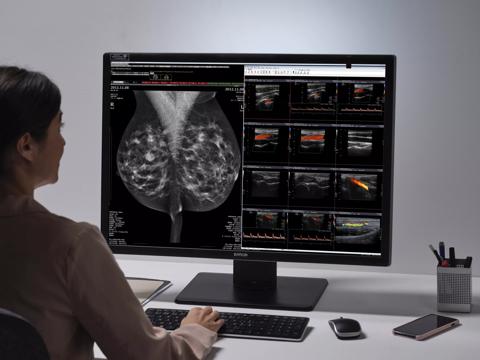What to consider when buying a breast imaging display
인사이트 - 유방 영상 4분 읽기
In digital breast imaging, a medical display is the eyes of the radiologist. It affects every decision you make. In this blogpost, we'll highlight two important display specifications to consider: display luminance and screen resolution.
1. Acquisition vs display
Before we dive into the world of breast imaging displays, it is important to understand the ins and outs of medical imaging. To get a digital breast image, you need a machine that actually takes the images. We call these machines acquisition or imaging systems. They come in all shapes and forms and create breast images with a specific resolution.
For example, the resolution of a mammogram captured by a GE digital mammography system is 2400 x 3070 pixels. The resolution of a mammogram taken by a Hologic machine, on the other hand, is 3328 x 4096 pixels.
Why is this important to know? The resolution of both the display and the acquisition system should match as closely as possible. This is also recommended by the American College of Radiology.(1) It’s the only way for radiologists to detect every image detail on the screen.
2. More screen, less clicks
It’s clear that the resolution of breast imaging displays is vital in the correct representation and interpretation of mammograms. A high display resolution brings nothing but benefits. First of all, radiologists can see details much clearer. Secondly, more resolution helps radiologists with their workflow.
How? In breast imaging, radiologists should view breast images in full size. If you have more vertical resolution, it is easier to fit the whole breast image on the screen.
Take a look at the following image. On a regular breast imaging display (5 megapixels), you need 4 steps to view every part of the breast image at 1:1. On a display with a slightly higher resolution (e.g. 5.8 megapixels), you only need 2 steps to read the same image.

A standard 5MP display requires 4 steps (clicks) to read the image. A 5.8MP display requires only 2.
3. Fusion increases productivity
Besides screen size and resolution, screen format is another important factor. A so-called Fusion format combines two stand-alone displays into one. This can be helpful for breast radiologists, in terms of reading productivity and ergonomics.
With a Fusion display, radiologists can place breast images where they want on the screen. This makes it easier for them to compare multiple images side by side, be it mammograms, breast ultrasounds or breast MRI.
Barco has a series of Fusion breast imaging displays that support flexible color multimodality imaging. It means 2D, breast tomosynthesis, ultrasound and breast MR images can be laid out anywhere on the screen.
4. Higher brightness, better detection
Resolution is not the only spec that defines the quality of a breast imaging display. Luminance is equally important. Multiple studies indicate that luminance impacts detection of small details during breast cancer screening.
Most breast imaging displays offer a high calibrated luminance of at least 500 candela. In some cases, this is not the maximum brightness the display can achieve. Special tools can help increase display luminance to 1000 candela or higher. Barco’s higher-end breast imaging displays have an internal luminance booster to increase the brightness of the display.
5. Higher brightness, faster workflow
Luminance boosters can also improve a radiologist’s reading speed and accuracy. Barco monitors come with a special tool, called SpotView. It increases luminance in a region of interest and dims the surrounding area. SpotView increases reading accuracy by up to 6.2% in the evaluation of mammography contrast-detail phantom.(2) What’s more, SpotView also reduces reading time by up to 15.5%.(2)
Conclusion
So what to look for when you buy a new breast imaging display? First of all, look further than a medical-grade design and resolution or luminance specs. Consider additional tools that can help to further boost display brightness. Also consider the impact of the display on reading ergonomics and workflow. If your reading routine is comfortable and productive, it will benefit both doctor and patient.
Sources
1. ACR–AAPM–SIIM Practice Parameter for Determinants of Image Quality in Digital Mammography, revised 2017
2. Krupinski, E. (2018). Reducing Radiation Dose in Digital Mammography by Increasing Display Luminance. Proceedings of SIIM, 2018


